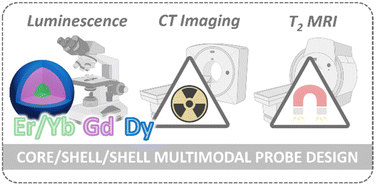Core–multi-shell design: unlocking multimodal capabilities in lanthanide-based nanoparticles as upconverting, T2-weighted MRI and CT probes†
Abstract
Multimodal bioimaging probes merging optical imaging, magnetic resonance imaging (MRI), and X-ray computed tomography (CT) capabilities have attracted considerable attention due to their potential biomedical applications. Lanthanide-based nanoparticles are promising candidates for multimodal imaging because of their optical, magnetic and X-ray attenuation properties. We prepared a set of hexagonal-phase (β)-NaGdF4:Yb,Er/NaGdF4/NaDyF4 core/shell/shell nanoparticles (Dy-CSS NPs) and demonstrated their optical/T2-weighted MRI/CT multimodal capabilities. A known drawback of multimodal probes that merge the upconverting Er3+/Yb3+ ion pair with magnetic Dy3+ ions for T2-weighted MRI is the loss of upconversion (UC) emission due to Dy3+ poisoning. Particular attention was paid to controlled nanoparticle architectures with tuned inner shell thicknesses separating Dy3+ and Er3+/Yb3+ to shed light on the distance-dependent loss of UC due to Yb3+ → Dy3+ energy transfer. Based on the Er3+ UC spectra and the excited state lifetime of Yb3+, a 4 nm thick NaGdF4 inner shell did not only restore but enhanced the UC emission. We further investigated the effect of the outer NaDyF4 shell thickness on the particles’ magnetic and CT performance. MRI T2 relaxivity measurements in vitro at a magnetic field of 7 T performed on citrate-capped Dy-CSS NPs revealed that NPs with the thickest outer shell thickness (4 nm) exhibited the highest r2 value, with a superior T2 contrast effect compared to commercial iron oxide and other Dy-based T2 contrast agents. In addition, the citrate-capped Dy-CSS NPs were demonstrated suitable for CT in in vitro imaging phantoms at X-ray energies of 110 keV, rendering them interesting alternatives to clinically used iodine-based agents that operate at lower energies.

- This article is part of the themed collection: Fundamental Processes in Optical Nanomaterials


 Please wait while we load your content...
Please wait while we load your content...